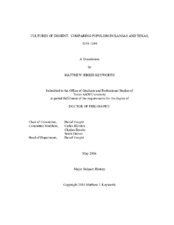| dc.description.abstract | In 1892, People’s Party candidate James Weaver won more than a million votes and four states in his bid for the presidency. Despite finishing third, the fledgling party’s promising start worried Democrats and Republicans alike. Although Populists demonstrated strength across the South and in the West, Kansas and Texas stood at the movement’s center.
Populism grew outward from areas first settled by whites in the 1850s. Farmers in both states initially struggled with new climates, crops, and soils, and they turned to neighbors for help in facing challenges great and small. The culture of mutual aid that developed enabled survival while forging a sense of community—and responsibility for the common weal—that endured through century’s end. In addition to impediments erected by Mother Nature, early homesteaders faced the obstacle of settling in contested places. Anxieties surrounding Bleeding Kansas ensnared even those who cared little about slavery, just as fear of “Indian depredations” consumed Texans. In both circumstances many believed that federal authorities at best ignored—and at worst added to—their problems.
Kansans and Texans walked divergent paths following the Civil War. The Sunflower State reaped the benefits of fighting for the victors and flourished socially through the early 1870s, as a multitude of fraternal, educational, and recreational organizations took root. Texas staggered through Reconstruction, but Republicans finally provided citizens in northern counties long-sought answers to “the Indian question,” loosening the Democratic Party’s grip on the region. By the 1880s, disaffected farmers in both states drew on cultures that prized mutual aid and voluntary association and encouraged skepticism of traditional party politics. Disparate paths converged by 1890, when rural Kansans and Texans arrived at the same solution to the economic problems that plagued them both: formation of a third party solely beholden to their interests. | en |


